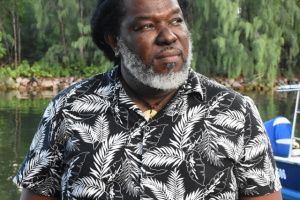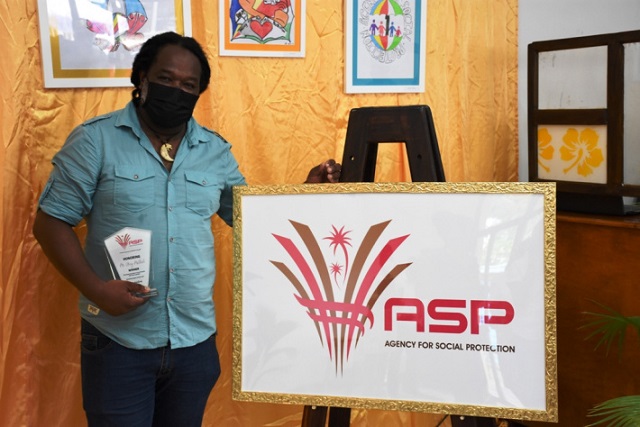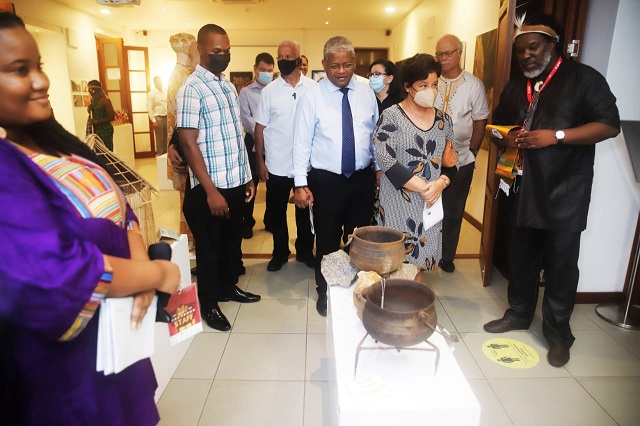Seychelles' multi-talented artist Urny Mathiot traces the road to 4 art forms of his life
The Interview |Author: Salifa Karapetyan Edited by: Betymie Bonnelame | June 16, 2022, Thursday @ 08:00| 22760 views
Although fine art was his first love, he later ventured into graphics and photography and then came to music where he set up his own band "Kod Nwar" (Black Codes) using African beats. (Seychelles Nation)
(Seychelles News Agency) - Seychellois Urny Mathiot, hailing from the central Mahe district of Mont Buxton, is a man of many talents - a painter, graphic artist, photographer and musician.
Although fine art was his first love, he later ventured into graphics and photography and then came to music where he set up his own band "Kod Nwar" (Black Codes) using African beats.
On May 25, to coincide with Africa Day, Mathiot organised an exhibition called AfrikArt which formed part of the local FetAfrik activities.
SNA met with Mathiot to learn more about his various passions.
SNA: How did your journey in the world of art start?
UM: I became interested in the arts at a very young age. I would naturally see myself scribbling on a piece of paper. My primary and secondary school teachers noticed my growing interest and encouraged me to continue. When I joined the National Youth Service (NYS) I started to specialise, did my O-Level and A-Level, and took art and design a little more seriously for three years.
My knowledge grew towards art and following my formation, I joined the Ministry of Culture in the early 2000s. I was employed as a graphic artist there, but I always kept in mind that I was trained as a fine art artist. It was difficult to make a living as a fine art artist as I only occasionally sold a piece. I did this as a profession for about 20 years.
SNA: When did you venture into doing photography and music?
UM: Even if I was employed, it didn't stop me from continuing to do fine art. Photography came in later. As a graphics designer, you work a lot with photos. At times when you rely on other people to provide these photos, they are not always what you had in mind and this is a problem.
So, I started taking my own photos and from there, my interest just kept on growing. I started attending courses and workshops and whenever there was a possibility, I would try my luck internationally. Doing this lets you pick up as much as possible and continue to make a breakthrough. I had to create a balance between fine art, photography and graphics.
And then as if things weren't enough, I had to move into the music world. This was something I was interested in for a while, and then everything fell into place. I placed my effort into music and today I have a band called 'Kod Nwar', through which I do hotel gigs. My world rotates around these four forms of art. I love living my culture in the sense that I always do my best to keep an identity alive, with an open mind.
SNA: Who was your inspiration when you first started?
UM: I always felt that to become a better artist, through all the stages, you need to let the world inspire you. By this, I mean that I do not really have a single or specific source of inspiration.
Through my art I make reference to everyday life - the human behavior, and things that set us back - I look for solutions to problems or express my disapproval of certain things. For me, there is no such thing as beautiful or ugly art, but rather it is a tool that can be used to make a difference in the lives of an individual, a nation or the world.
 |
| Mathiot was the winner of the competition to design the logo of the Agency for Social Protection. (Seychelles Nation) Photo License: CC-BY |
SNA: You practice four different art forms. What unites all of them?
UM: 'Kod Nwar' is not just a band. It is my own cultural movement through which I want to accomplish so much. The Black Codes have roots in colonial times when it was a document used against dark-skinned people. It dictated what a slave could and couldn't do. Today, these codes still have an effect on the present.
Through 'Kod Nwar', I try to show the positive sides of the black race. Don't judge Africa as a continent that witnesses only bad things. This has impacted the people there a lot. There are a lot of good things that originate from mainland Africa. I also try to illustrate events that are not acceptable and happening to black people and society - this comes out in my photography, paintings, music, and graphics.
Through music, I find it easier to do this. Even if I want to create some fusion, I know that my music has to do with where I am located and what makes me a person, in terms of where I was born. At the same time, I need to understand my heritage and use some past influences in terms of sounds that I have heard others produce and what I am still hearing coming from nature.
In a way, by doing this I am creating my own identity. If you want to invent certain things in terms of musical instruments or a different style of playing an instrument, know that this will represent you in any show or album you produce. An artist should be able to create their own culture. Most of our connection is linked with the mainland.
SNA: How would you say art has evolved in Seychelles and what needs to be improved?
UM: Things have changed. With lots of development taking place, we have become more open to the outside world and people have gotten more experienced. Many have been able to experience other cultures, carried out further studies and now they understand that a living can be made with art. In all the art forms in Seychelles, we have some very capable people. With evolution, good understanding and education, the upcoming generation sees art can put together really strong projects. It all has to do with a person's mindset.
Mentalities need to change especially when it comes to visual art. It is not always a question of an artist being well trained. It is also not a dishonour to be self-taught, however, the more you research about something, the better it gets. There are three steps you need to go through - preparations for today should have been done yesterday, and today you prepare for tomorrow. There is still a lack of education that will allow artists to achieve more. I do not in any way say this in a bad way. There is always room to improve and this is done through practice and research.
SNA: The latest exhibition you organised was in FetAfrik. Tell us more about it.
UM: That particular exhibition, which was a collaboration with many other artists, is one that I have done before. AfriKArt Seychelles is not something new for me. For two years we haven't been able to put together an exhibition for the occasion. This year I decided to approach the Institute of Culture asking if I could have such an exhibition during the scheduled events.
 |
| Mathiot (1st right) showing invited guests around the FetAfrik exhibition. (Joe Laurence, Seychelles News Agency) Photo License: CC-BY |
I didn't want to do a solo exhibition so I got in touch with other artists, including Leon Radegonde, Steve Marie and Jude Ally, among others. They were quite positive about the initiative. These are artists who have African influences in their work. They didn't have to make a special effort for the exhibition, but rather their personal style matched the exhibition.
The selection of artists displayed some symbolic work, and only by looking at their art, you could tell whose it was. If you were to place them in an exhibition on the mainland [Africa], they would look local. At the end of the day, the exhibition was a success as the artists really appreciated it since their works have not been exposed over the past years. The exhibition was a platform that allowed the public to know that they were still around and making art.
SNA: What are your plans for the future?
UM: There are so many of them but I can't say much. I still want to learn and discover more about art. This will determine the evolutions of projects that I will come up with. By doing some more research, I will be able to tap into other things. I also want to give more where I can.
Back
